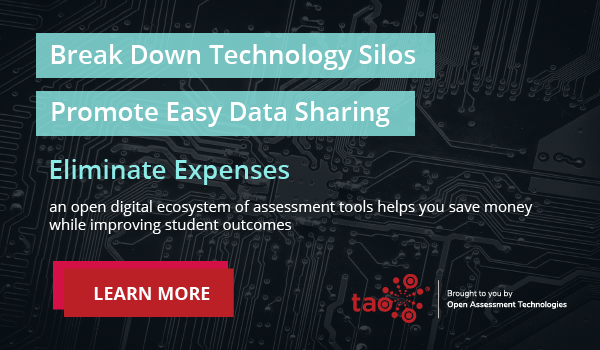What is interoperability? Simply put, interoperability describes how well systems, applications and the data within them interact within an organization. When it comes to educational institutions, interoperable technology allows students to access a wider range of tools while enabling schools to easily share and manage data systems.
Interoperable technology in education delivers capabilities, like seamless data sharing, that are reshaping the classrooms of the future. Equipped with interoperable systems, schools can create authentic assessments with higher rates of effectiveness–from individual student to district-wide levels. In fact, to realize the full potential of EdTech, building an interoperable tech ecosystem is crucial to any modern school or district.
Lack of Interoperability Leads to Siloed Data in Education
Many education leaders view personalization as the holy grail of education. However, personalization is a significant undertaking. Providing individual guidance requires accessing to and analyzing mounds of data collected over the course of each learner’s journey. Unfortunately, that data often lives alone, inhabiting just one static space in your EdTech ecosystem — a space where the data may be difficult to access, analyze and use for better student outcomes.
While engineers often create closed applications for the sake of security, siloing data is problematic in education. Narrowly restricted data access inhibits student accommodations, limits communication across the district, and halts integrated instruction. After all, data is only useful when it’s accessible (and when structured properly, accessible data can still be secure).
Many tech vendors, however, often treat interoperability as an afterthought. Some even admit that they prefer to keep their users captive by preventing the easy sharing of data across systems. As a result, personalization attempts are hampered before they’ve even begun.
Benefits of Interoperability for Educational Institutions
Interoperability enables institutions to share data seamlessly. However, the benefits of an interoperable tech stack within the school system extend far beyond basic data accessibility. Consider the value of building an interoperable ecosystem into your school system: you’ll be encouraged and even mandated to leverage platforms and applications that are built for the exact purpose of optimal and secure data sharing.
Interoperable Systems Help Improve the Educational Experience
Today, trusting the systems within your institution is key to operations geared toward optimal educational outcomes. According to the CEO of IMS Global, trust is perhaps the most important when establishing an interoperable system:
“When it comes to data and analytics in education, trust is everything. All other progress is dependent on establishing trust in the data and in the ecosystem.” — Rob Abel, Ed.D.
With this perspective on technology purchases, your educational institution can execute integrations with ease, providing functionality that enhances personalization and the overall educational experience. For instance, an open architecture assessment tool enables custom reporting and automated scoring capabilities. This not only saves your teachers time on grading, but informs future instruction while evaluating the current state of instruction.
Equally as important as tech tools themselves is the concept of evolution in education. If your technology stack is not interoperable, every new system will create new silos—which limits growth in education. With interoperability as the guiding light for technology procurement, you can add new systems to your stack that move your students, teachers, school, and district forward.
Interoperability Reduces Technology Expenses
Evolution is critical to optimal educational outcomes, but you can’t build up your EdTech stack without certain considerations — like Total Cost of Ownership (TCO). Districts use many third-party assets, platforms and online tools for instruction and assessments. If these systems aren’t working together, the costs only increase.
According to the CEO of IMS Global Learning Consortium, cost is directly related to how effectively your organization can scale:
“Cost per integration is the enemy of scale. And we know we need to scale to enable diversity, equity, and personalization in the EdTech sector.” — Rob Abel, EdD.
Interoperability allows for a reduction in TCO without compromising tech capabilities, while enabling rapid and sustainable growth. In fact, it can enhance your existing tools and modernize the system-wide approach to education.
Start Optimizing Your Data
Modern institutions are combating restrictive data practices by building interoperable ecosystems that fuel personalization and allow authentic assessments to thrive. To ensure interoperability of all educational tools, your organization should follow open interoperability standards, like the industry standards set by IMS. Open interoperability standards can enable your EdTech apps and platforms to operate efficiently with one other — and deliver real results to students and education leaders.
Ensure the interoperability of your systems with these tips:
- Align all new online testing tools or other technologies with the strategic plans set by the school, district or state.
- Check for IMS certification on all new products or technologies.
- Increase efforts toward aligning education and IT teams, creating a transparent line of communication that ensures seamless integration and application of new technology.
A lack of interoperable technology forces teachers and officials to waste time and resources managing teaching tools and the data within them, instead of teaching or focusing on strategic tasks. By following open standards, your institution or district can eliminate reliance on vendors who insist on silos — as any system or application can be replaced as needed.
The Bottom Line
To realize the full potential of technology for modern education, it is crucial that district and state leaders procure solutions that are truly open. By using technology that optimizes testing data while seamlessly integrating with existing systems, schools and districts can create tests that deliver valuable information, make tests more engaging for students, and deliver optimal learning outcomes. At the end of the day, that’s what educators, parents, and students truly want.


